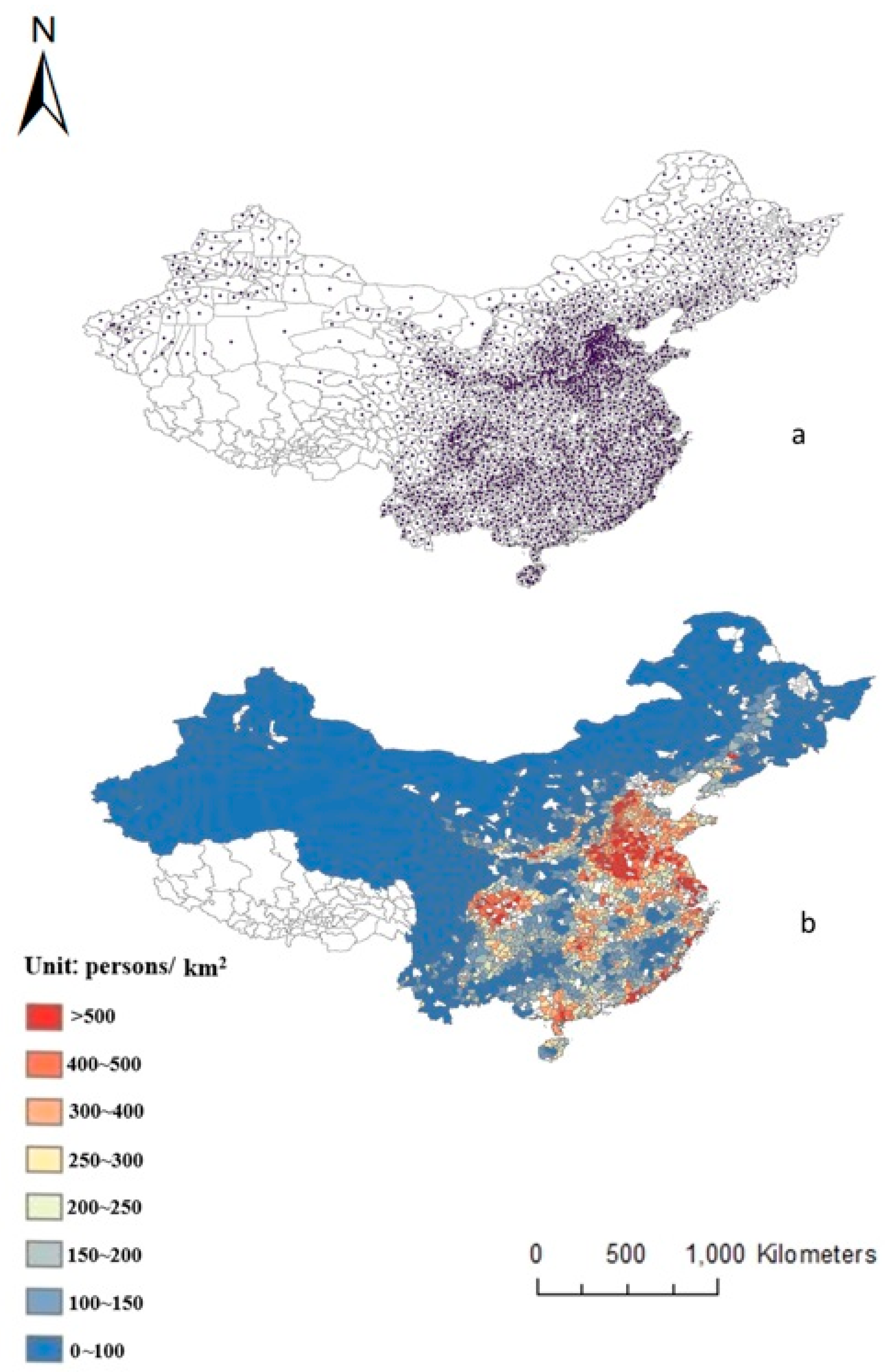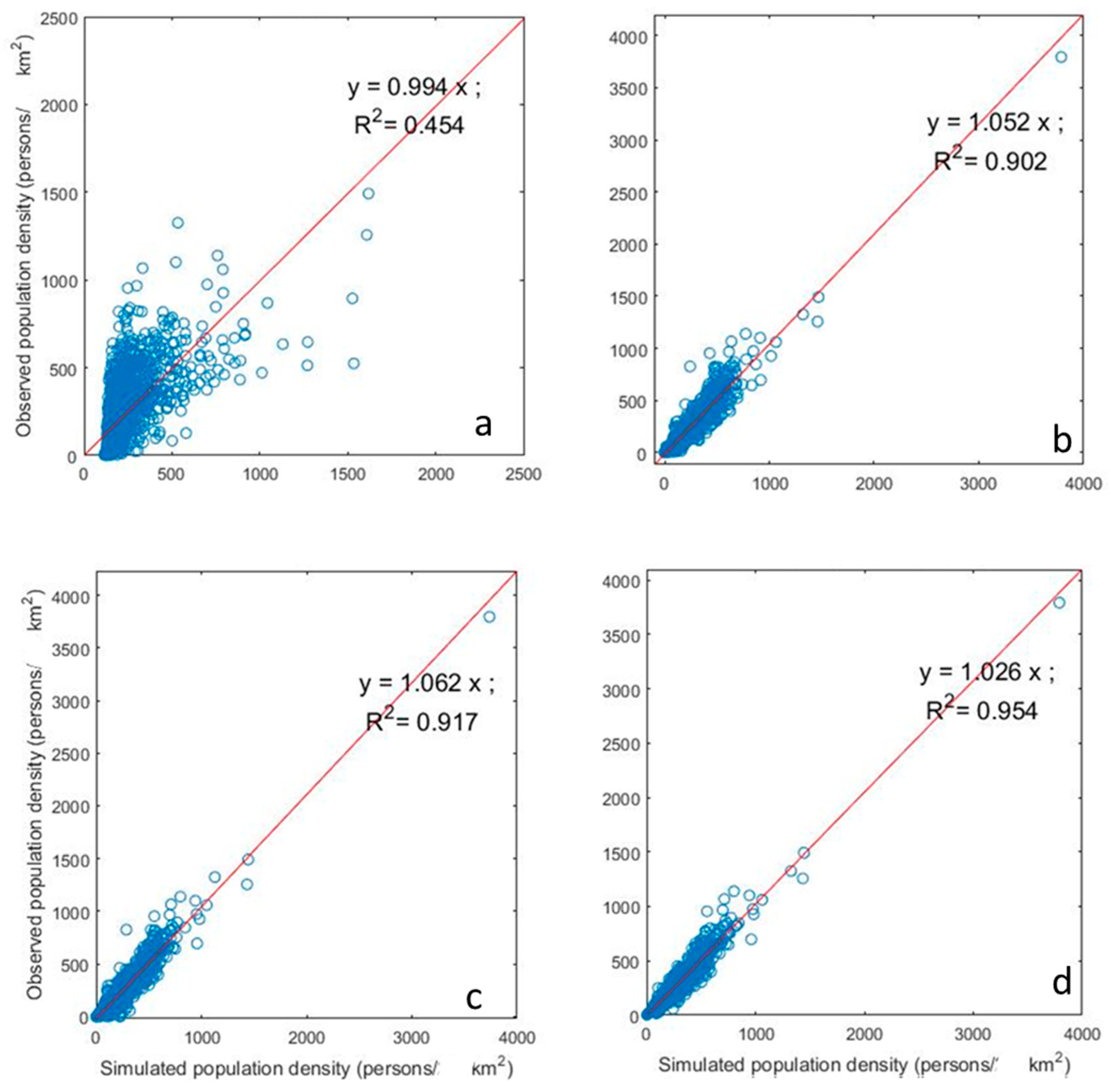Adaptive Non-Negative Geographically Weighted Regression for Population Density Estimation Based on Nighttime Light
Abstract
:1. Introduction
2. Materials and Methods
3. Results
3.1. Model Comparisons among OLS, GWR, NNGWR, and ANNGWR
3.2. ANNGWR Details
3.3. Temporal Population Density Maps
4. Conclusions
Author Contributions
Funding
Acknowledgments
Conflicts of Interest
References
- Sutton, P. Modeling population density with night-time satellite imagery and GIS. Comput. Environ. Urban Syst. 1997, 21, 227–244. [Google Scholar] [CrossRef]
- Mellander, C.; Lobo, J.; Stolarick, K.; Matheson, Z. Night-time light data: A good proxy measure for economic activity? PLoS ONE 2015, 10, e0139779. [Google Scholar] [CrossRef] [PubMed]
- Li, Q.; Lu, L.; Weng, Q.; Xie, Y.; Guo, H. Monitoring urban dynamics in the southeast USA using time-series DMSP/OLS nightlight imagery. Remote Sens. 2016, 8, 578. [Google Scholar] [CrossRef]
- Sun, W.; Zhang, X.; Wang, N.; Cen, Y. Estimating population density using DMSP-OLS night-time imagery and land cover data. Analysis 2017, 8, 60. [Google Scholar] [CrossRef]
- Rayner, P.J.; Raupach, M.R.; Paget, M.; Peylin, P.; Koffi, E. A new global gridded data set of CO2 emissions from fossil fuel combustion: Methodology and evaluation. J. Geophys. Res. Atmos. 2010, 115. [Google Scholar] [CrossRef]
- Gillespie, T.W.; Frankenberg, E.; Fung Chum, K.; Thomas, D. Night-time lights time series of tsunami damage, recovery, and economic metrics in Sumatra, Indonesia. Remote Sens. Lett. 2014, 5, 286–294. [Google Scholar] [CrossRef] [PubMed] [Green Version]
- Elvidge, C.D.; Baugh, K.E.; Kihn, E.A.; Kroehl, H.W.; Davis, E.R. Mapping city lights with nighttime data from the DMSP Operational Linescan System. Photogramm. Eng. Remote Sens. 1997, 63, 727–734. [Google Scholar]
- Fan, C.C. Population Change and Regional Development in China: Insights Based on the 2000 Census. Eurasian Geogr. Econ. 2002, 43, 425–442. [Google Scholar] [CrossRef]
- Bustos, M.F.A.; Hall, O.; Andersson, M. Nighttime lights and population changes in Europe 1992–2012. Ambio 2015, 44, 653–665. [Google Scholar] [CrossRef] [PubMed] [Green Version]
- Lo, C.P. Modeling the population of China using DMSP operational linescan system nighttime data. Photogramm. Eng. Remote Sens. 2001, 67, 1037–1047. [Google Scholar]
- Fotheringham, A.S.; Brunsdon, C.; Charlton, M. Geographically Weighted Regression: The Analysis of Spatially Varying Relationships; John Wiley & Sons: Hoboken, NJ, USA, 2003. [Google Scholar]
- Li, L.; Lu, D. Mapping population density distribution at multiple scales in Zhejiang Province using Landsat Thematic Mapper and census data. Int. J. Remote Sens. 2016, 37, 4243–4260. [Google Scholar] [CrossRef]
- National Bureau of Statistics of China. China Statistical Yearbook for Regional Economy 2008–2014 (Zhongguo Quyu Jingji Tongji Nianjian 2008–2014); National Bureau of Statistics of China: Beijing, China, 2009–2015.
- Howden, D.; Zhou, Y. Why Did China’s Population Grow So Quickly? Indep. Rev. 2015, 20, 227–248. [Google Scholar]
- Chu, H.J.; Huang, B.; Lin, C.Y. Modeling the spatio-temporal heterogeneity in the PM10–PM2.5 relationship. Atmos. Environ. 2015, 102, 176–182. [Google Scholar] [CrossRef]
- Lawson, C.L.; Hanson, R.J. Solving Least Squares Problems; SIAM: Philadelphia, PA, USA, 1995. [Google Scholar]
- Anselin, L. Local indicators of spatial association—LISA. Geogr. Anal. 1995, 27, 93–115. [Google Scholar] [CrossRef]
- Tu, J.; Xia, Z.G. Examining spatially varying relationships between land use and water quality using geographically weighted regression I: Model design and evaluation. Sci. Total Environ. 2008, 407, 358–378. [Google Scholar] [CrossRef] [PubMed]
- Chu, H.J. Assessing the relationships between elevation and extreme precipitation with various durations in southern Taiwan using spatial regression models. Hydrol. Process. 2012, 26, 3174–3181. [Google Scholar] [CrossRef]
- Rohlfs, C.; Zahran, M. Optimal Bandwidth Selection for Kernel Regression Using a Fast Grid Search and a GPU. In Proceedings of the 2017 IEEE International Parallel and Distributed Processing Symposium Workshops (IPDPSW), Orlando, FL, USA, 29 May–2 June 2017; pp. 550–556. [Google Scholar]
- Tan, M.; Li, X.; Li, S.; Xin, L.; Wang, X.; Li, Q.; Li, W.; Li, Y.; Xiang, W. Modeling population density based on nighttime light images and land use data in China. Appl. Geogr. 2018, 90, 239–247. [Google Scholar] [CrossRef]
- Zeng, C.; Zhou, Y.; Wang, S.; Yan, F.; Zhao, Q. Population spatialization in China based on night-time imagery and land use data. Int. J. Remote Sens. 2011, 32, 9599–9620. [Google Scholar] [CrossRef]
- Lu, H.; Zhang, M.; Sun, W.; Li, W. Expansion Analysis of Yangtze River Delta Urban Agglomeration Using DMSP/OLS Nighttime Light Imagery for 1993 to 2012. ISPRS Int. J. Geo-Inf. 2018, 7, 52. [Google Scholar] [CrossRef]
- Kumar, P.; Sajjad, H.; Joshi, P.K.; Elvidge, C.D.; Rehman, S.; Chaudhary, B.S.; Tripathy, B.R.; Singh, J.; Pipal, G. Modeling the luminous intensity of Beijing, China using DMSP-OLS night-time lights series data for estimating population density. Phys. Chem. Earth Parts A/B/C 2018. [Google Scholar] [CrossRef]








| Time | Model | RMSE (Persons/km2) | R2 | Global Moran’s I of Model Residuals |
|---|---|---|---|---|
| 2004 | OLS | 156.4 | 0.35 | 0.4381 |
| GWR | 61.9 | 0.90 | 0.0106 | |
| NNGWR | 67.7 | 0.88 | 0.0267 | |
| ANNGWR | 50.2 | 0.93 | 0.0087 | |
| 2007 | OLS | 155.3 | 0.45 | 0.0501 |
| GWR | 68.2 | 0.90 | 0.0417 | |
| NNGWR | 72.5 | 0.88 | 0.0220 | |
| ANNGWR | 56.4 | 0.94 | 0.0058 | |
| 2010 | OLS | 166.1 | 0.33 | 0.3537 |
| GWR | 66.2 | 0.91 | 0.0027 | |
| NNGWR | 73.1 | 0.89 | 0.0242 | |
| ANNGWR | 55.7 | 0.94 | 0.0042 | |
| 2013 | OLS | 164.9 | 0.48 | 0.3091 |
| GWR | 64.9 | 0.92 | 0.0053 | |
| NNGWR | 72.8 | 0.89 | 0.0316 | |
| ANNGWR | 57.7 | 0.94 | 0.0050 |
© 2019 by the authors. Licensee MDPI, Basel, Switzerland. This article is an open access article distributed under the terms and conditions of the Creative Commons Attribution (CC BY) license (http://creativecommons.org/licenses/by/4.0/).
Share and Cite
Chu, H.-J.; Yang, C.-H.; Chou, C.C. Adaptive Non-Negative Geographically Weighted Regression for Population Density Estimation Based on Nighttime Light. ISPRS Int. J. Geo-Inf. 2019, 8, 26. https://doi.org/10.3390/ijgi8010026
Chu H-J, Yang C-H, Chou CC. Adaptive Non-Negative Geographically Weighted Regression for Population Density Estimation Based on Nighttime Light. ISPRS International Journal of Geo-Information. 2019; 8(1):26. https://doi.org/10.3390/ijgi8010026
Chicago/Turabian StyleChu, Hone-Jay, Chen-Han Yang, and Chelsea C. Chou. 2019. "Adaptive Non-Negative Geographically Weighted Regression for Population Density Estimation Based on Nighttime Light" ISPRS International Journal of Geo-Information 8, no. 1: 26. https://doi.org/10.3390/ijgi8010026
APA StyleChu, H.-J., Yang, C.-H., & Chou, C. C. (2019). Adaptive Non-Negative Geographically Weighted Regression for Population Density Estimation Based on Nighttime Light. ISPRS International Journal of Geo-Information, 8(1), 26. https://doi.org/10.3390/ijgi8010026






